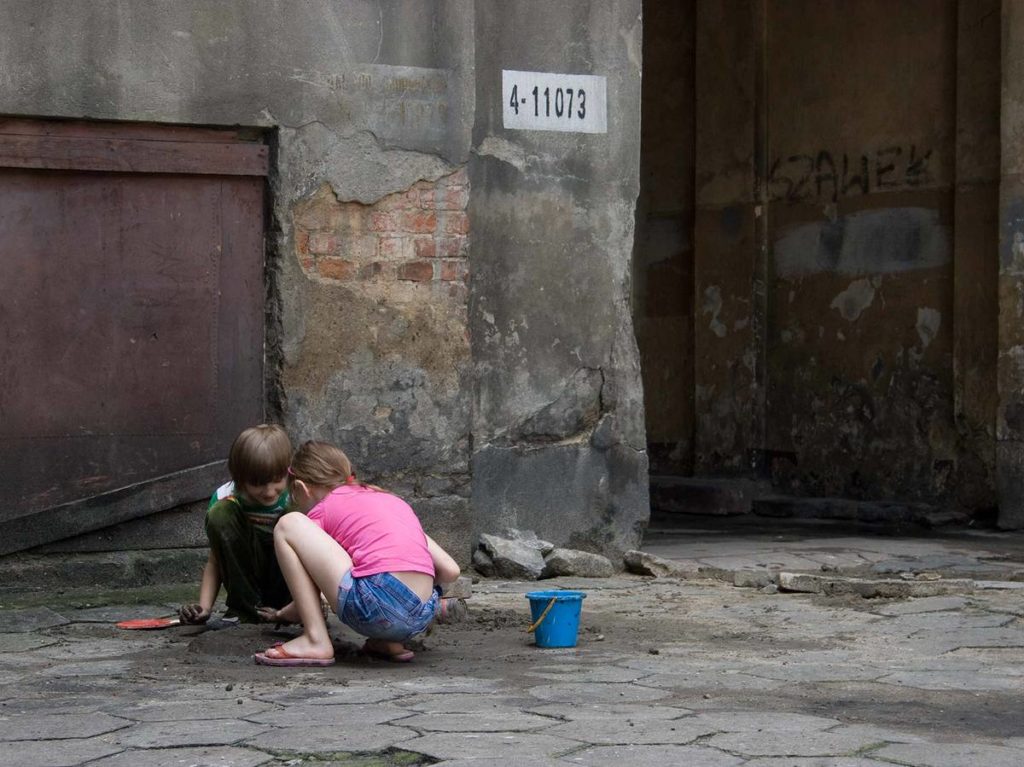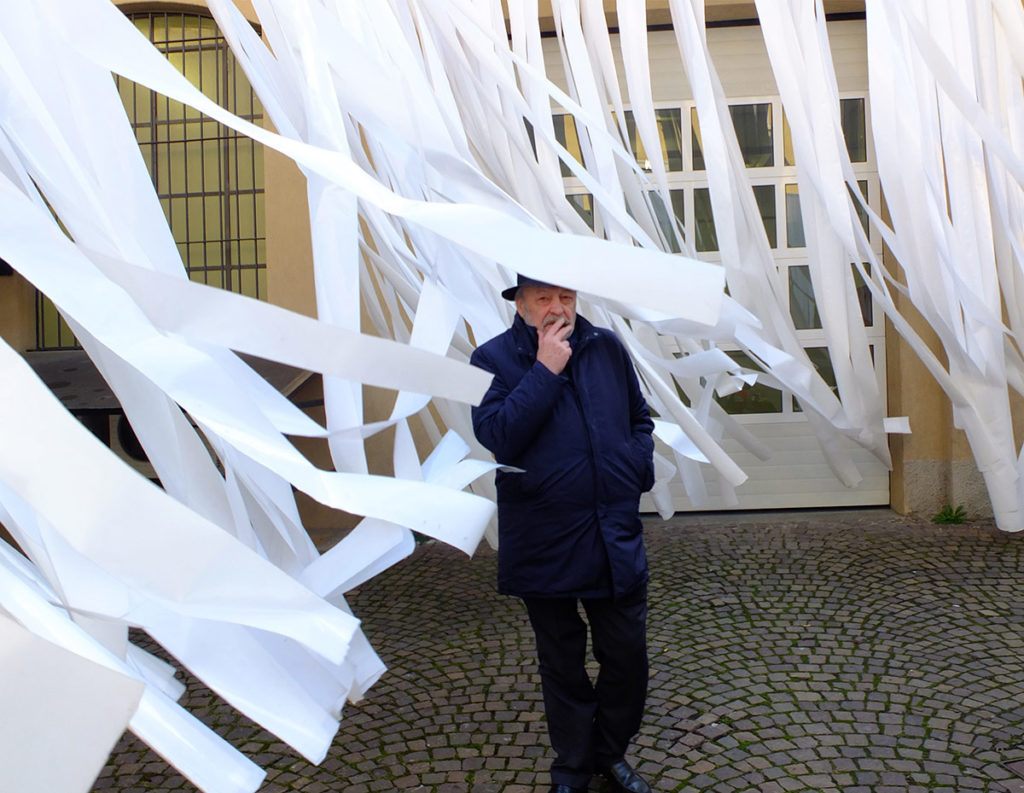Away from any documentary convention and any narrative velleity, Sharon Lockhart’s films confront the viewer with a phenomenological approach to time and landscape, through long still scenes. Most of her projects are the result of real-time scanning of small groups of individuals in precarious situations. Combining conceptual rigor and the poetry of the present moment, these paintings of the everyday plunge the spectator into a simultaneous state of meditation and reflection.
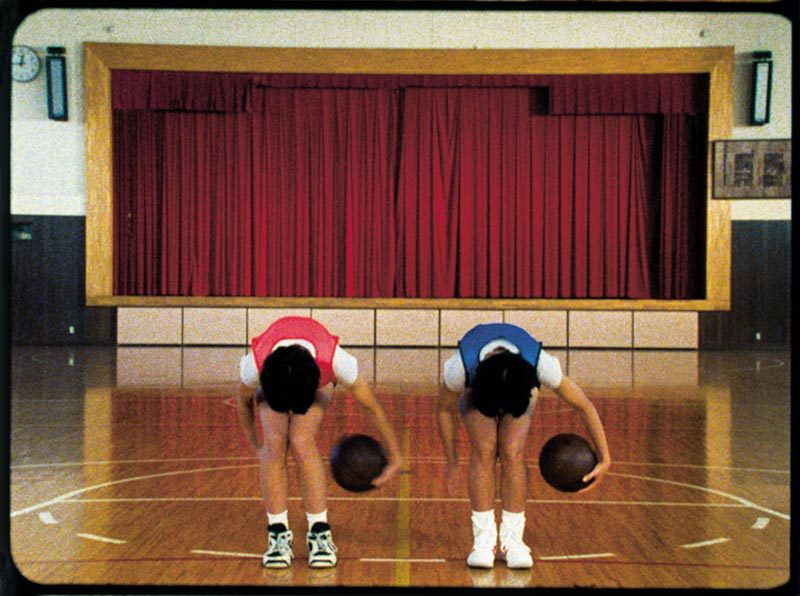
Sharon Lockhart, Goshogaoka, 1997 (film still), 16mm film, color/sound, 63 min. © Sharon Lockhart. Courtesy the artist; Gladstone Gallery, New York and Brussels; neugerriemschneider, Berlin
Continuing her work on movement within a fixed frame, and on the relationship of the body to space, Sharon Lockhart is on the lookout for the tiniest details that weave the course of existence. Details that take on a striking intensity over time: such sound in the distance, such gestures, such mischievous play, such oscillation of foliage, such touch of light… But Sharon Lockhart’s approach, in the footsteps of Chantal Akerman or James Benning, cannot be reduced to a film or photographic object dedicated to pure contemplation. It is above all a long-term process, an anthropological and social survey that is accompanied by a long immersion in the environment she has chosen to examine, sometimes associated with an educational program set up at the very place of shooting. This close collaboration – but above all, mutual trust – is established over a period of several years with various communities, filmed in the time allotted by each reel of film. Her gaze has been focused successively on a women’s basketball team in Japan (Goshogaoka, 1997), the spectators of an opera in Manaus (Teatro Amazonas, 1999), a couple of Japanese farmers practicing Ikebana (NO, 2003), a group of kids playing in the depths of the Sierra Nevada (Pine Flat, 2005), workers during their lunch break (Lunch Break, 2008) and on leaving the factory (Exit, 2008), a clam digger at dawn (Double Tide, 2009), children taking over the courtyards of ruined buildings in the town of Łódź (Podworka, 2009), young Polish orphan girls placed in a Social Therapy Center (Rudzienko, 2016) . The a priori insignificant moments are precisely those on which the artist concentrates all her attention. The location of the camera and the microphone are decisive, and it is by focusing on small details of reality, tiny actions and interactions with the environment, that life becomes a theater stage: the sound atmosphere becomes an object of meditation and the slightest gesture becomes choreography. For her latest project to date, she has collected the anonymous words of women incarcerated at the Baumettes prison in Marseille (France), suffering humiliation and abuse from the guards and the prison administration. The result is a film without images, made remotely during the first lockdown in spring 2020, and which should lead to a project of installation in 2021. From structural cinema to sociotherapy, empowerment is in the scope.
JB : There’s recurring topics in your work : the passage rite from adolescence to adulthood, and the relationship between a human being and his environment, but also the multiplied perception of time and the cultural impact of language. Do you know precisely what you are trying to achieve before starting the shoot? Do you have a structural protocol in mind for each of your projects? How do you decide where you’re going to shoot ?
SL : You mention four topics here and I would say there are others as well. As I’ve said elsewhere, my projects generally evolve over a long period of time and involve a significant period of research at the beginning. Often, they begin by happenstance with a place, person or community, or concept. Since much of what I’m doing is based on research and discussions with the people I’m working with, I don’t think there is one project that I knew precisely what I wanted to achieve before I started. Coming up with the structural protocols often happens midway through the project after I’ve had some time to process the information that I’m grappling with. I definitely do spend a lot of time trying to rethink structural approaches as I’m hitting new ground with each project and challenge the work before it. With Rudzienko (2016), for instance, I spent over a year trying out different approaches and realized at the end that the concept I had at the very beginning, relating to language, would provide the main structural element to the film. Locations obviously are important and sometimes they present themselves as obvious choices but, more often, I spend a significant amount of time scouting locations at the beginning of a project.
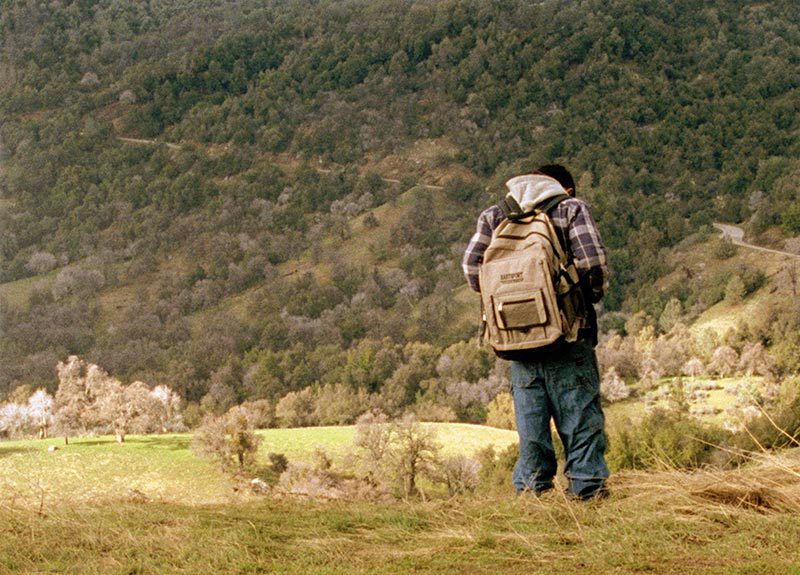
Sharon Lockhart, Pine Flat, 2005, (film still), 16mm film, 138 min. © Sharon Lockhart. Courtesy the artist; Gladstone Gallery, New York and Brussels; neugerriemschneider, Berlin
JB : Your movies are often depicting a single human activity in real time. You’re developing a dialectic between the repetitiveness of labor of adulthood and the refreshing playfulness of youth. What strikes me is the way you’re managing to juxtapose many layers of perception, quite distinct from each other: children playing, dancing or doing sports, adults working, landscape changing, your camera filming without interruption and the spectator watching this sustained moment in life. Those multiple perceptions of time and space appear simultaneously to reach some sort of structural objectivity.
SL : As I thought about your question, I went back in my mind over all of the projects to assess if there really were very different approaches to time on the part of adults and children. While adults are more aware of time, in the films I’ve made, most of the adults are as in-the-moment as the children are. I think what I’ve tried to do is make duration and the perception of time an issue for audiences. I would like them to think about time in a way that conventional filmmaking does not. I would say conventional film tries to erase your awareness of time both as a viewer and as it is perceived by the subjects on camera.
JB : How do you “stage” the scenes of your films ? Do you follow a written script? Are people acting under specific directions or you just let them act and discuss spontaneously? You seem to have a direct and empathetic relationship with them.
SL : There is rarely such a thing as a script. Actually, only in my first film, Khalil, Shaun a Woman Under Influence (1994). What makes filming interesting for me is the way unexpected or unplanned things happen in front of the camera. That is not to say that there isn’t a plan or a lot of direction given. Since most scenes are just a single shot, I spend a good deal of time figuring out the frame and explaining its parameters to the “actors”. We generally have an idea of what they are going to do in the shot and have worked out the timing and choreography. You are right that a relationship is established with the subjects prior to the filming. I do really need to know them, and they need to know me and have an investment in the project for it to work. There needs to be trust there. Since we don’t have a script, we have to have a shared sensibility for it to work.
JB : For the preparation of Rudzienko (2016), you worked closely with the Youth Center for Socio-Therapy in Warsaw. How did you find out that location? How long did you spend in this community of teenage girls and how long did the shooting last?
SL : That project started with Milena, one of the children I met while shooting Podworka in 2009. We continued our relationship and, when she moved to the Youth Center in 2013, I started talking to the institution about doing a series of workshops with the girls and possibly making a film. I rented a different farm each summer and the filming happened there. The first shoot took about 6 weeks but then I returned the next summer for another month and had several more visits to work on sound recordings and workshops for the girls. Then the project merged into “Little Review”, an installation for the Venice Biennale where I represented Poland in 2017, and a film I am finishing that I shot with Milena and the girls in Gotland, Sweden. Altogether, from Podworka until now, it has been 10 years.
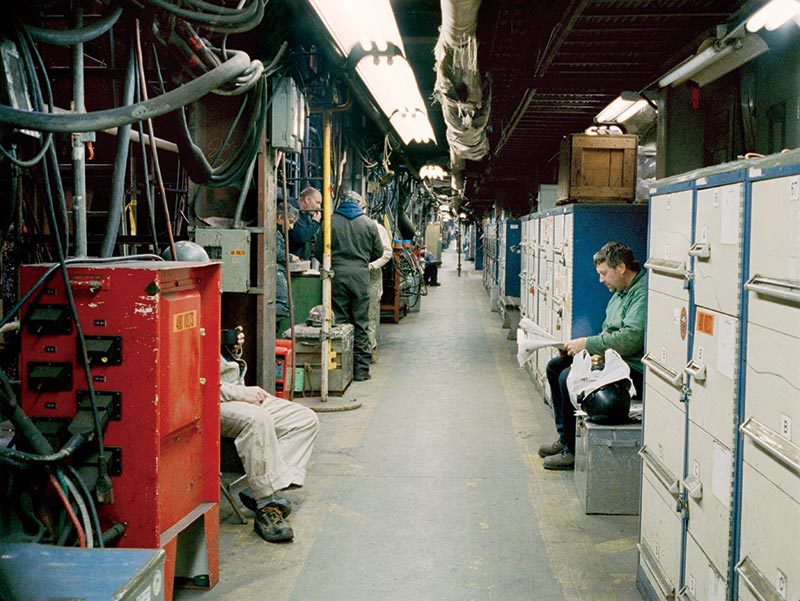
Sharon Lockhart, Lunch Break, 2008 (film still), 35mm film transferred to HD, color/sound, 83 min. © Sharon Lockhart. Courtesy the artist; Gladstone Gallery, New York and Brussels; neugerriemschneider, Berlin
JB : In the long list of credits, there’s mention of movement therapy, philosophy, theater, improvisation, mindfulness, dream awareness, farming… The preparation before the shooting seems as much important as the shooting itself. Can you tell us more about the workshop you conducted and the activities of the center?
SL : The workshops were a central part of this Rudzienko. Although the viewer is not aware of them until the end credits. It is only then that you realize the amount of time that was spent establishing the relationships between the girls, me, the workshop leaders, and the camera. I think it makes the film a new film or it makes you question the way you read the film without knowing that information prior. I have done this in a lot of my works. In Goshogaoka (1997) you read in the end that it was costumed and choreographed. That film was written about as a documentary by Sundance, which I thought was funny but made sense because I was thinking a lot about the way one culture reads another. At the Youth Center, they did not have programming for the girls. That is probably the reason why they were happy with my project. Through my relationship with Milena, I knew that these girls did not have an easy childhood and that it would be harder when they aged out of the system. The project was inspired by Milena’s desire to write a book about her life but that wasn’t easy for her to articulate so we structured the first summer around talking and working with a philosopher. One of the defining characteristics of the girls in the center was that they felt no one listened to them or cared what they thought. The more I learned about them, the more I thought of ways in which we might be able to offer workshops to help them cope with their situation. The second year we expanded the workshops to include more physical things and in the third year and afterwards, we did many more practical things like a workshop with a chef to make healthy food on a budge, making a resume, or getting an internship.
JB : I find especially riveting your way of being attentive to the precise intersection between the mundane and the immanence, the joy of being alive and the existential depth that reflects on seemingly ordinary conversations between those young polish women. You draw attention to micro-events in everyday life that might seem unremarkable at first glance and turn them into an out-of-time experience. Do you find a large cultural gap between those girls from Poland and the ones you shot in rural areas of California?
SL : The issues were very similar in the two very different places. Culturally, there are obviously strong differences but I would say that socioeconomically both sets of children came from lower middle class households and faced many similar issues. I should emphasize that in Poland I was working with a group of girls that had been moved from their homes to the sociotherapy center and in Pine Flat (2006), the children in the rural town lived with their families or foster families. In Poland the issue of Catholicism is at the center of everything and many of these girls were struggling with their identity not being recognized by mainstream society. Alcoholism is also a huge issue in Poland and I would guess that a good portion of the teens I worked with either came from homes in which that was an issue or where they had developed substance abuse issues themselves. Physical and sexual abuse were issues as well. None of these things are unfamiliar to America. One reason why I think the work resonated with me and with audiences is that much of the content cut across social, political, and cultural divides. In the face of the difficulties that many of the girls in the youth center faced, their resiliency, hopes and dreams, and sheer joy were uplifting.
JB : The alternance of natural sound and silence is often in the foreground in your films, I’m thinking in particular of the opening scene of Pine Flat where everything is played off-screen and through the cries of children that can be heard echoing in the distance. Can you talk about the room you give to sound in your work?
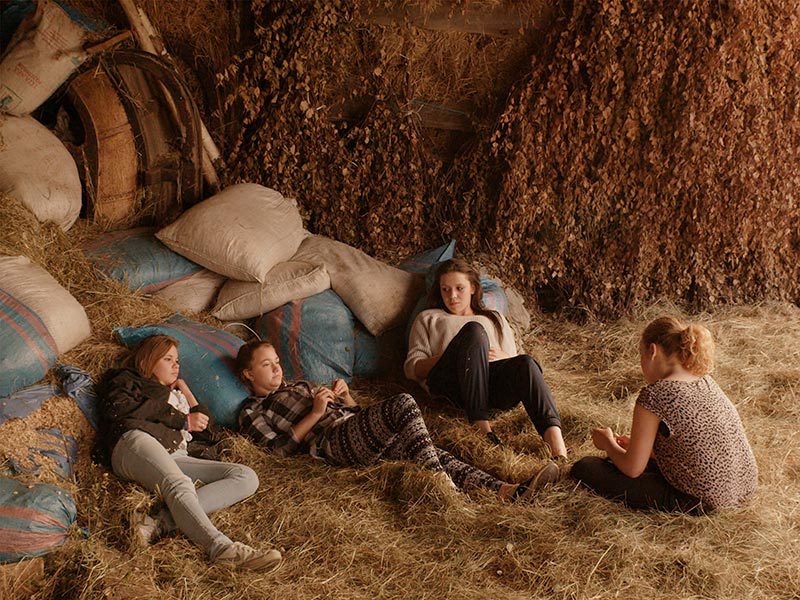
Sharon Lockhart, Rudzienko, 2016 (film still from a two channel film installation), 48 min. 41 sec. © Sharon Lockhart. Courtesy the artist; Gladstone Gallery, New York and Brussels; neugerriemschneider, Berlin
SL : I do a lot of work on the sound and think it is very important in my work. I’m glad you noticed. Since the images in my films give viewers a lot of time to perceive and consider the frame and what they are witnessing, the sound offers a texture that you might not have time for in more conventional films. I see it as a place where I can add a lot of complexity. I think, in general, we don’t spend a lot of time noticing sound. In conventional movie making, and even in art videos, music and talking are taking over the ambience sounds. On top of that, quick cuts enable filmmakers to pay little attention to the main ambient sound. In a lot of art video installations, there tends to be a very dramatic overdoing of sound – lots of drama. When you don’t have those crutches, you realize how much there is to pay attention to. Offscreen sound is something I love to work with to push the viewer out of the image. It makes them more aware of sound. On Double Tide (2009), I had a sound recordist who came highly recommended and when I asked him to spend an hour each morning (before sunrise) and each evening (after sunset) doing field recordings. He could not understand it. After the third day he quit. On the recordings later I heard him saying, “same thing – nothing here to listen to”. For me, the sound was wonderful. There is such subtlety in the texture of the sound in the offscreen forest, the boats going in or out for the day, the birds, crickets, and the way the sound changes as a day opens and closes.
JB : Why did you choose to compartmentalize the English translation of the Polish dialogues into scrolling inserts?
SL : The main issue I struggled with was how to deal with subtitles. I wanted viewers to pay attention to all the details of the picture and the sound of the girls’ voices in Polish. When you are reading, you hear your own voice and are primarily paying attention to the text in front of you. This is why I chose to separate the image and voices from the text and present the translated texts in silence. I wanted viewers to take the time to consider what a subtitle is and what the different conditions of viewership are when presented by a text.
JB : You worked in 2012 on an installation based on Eshkol-Wachmann Movement Notation movements. How did you come across EWMN system and how did the collaboration with Noa Eshkol take place? What grabbed your attention in this notation system, little known outside the scientific and choreography fields?
SL : This project was the result of a research residency in Tel Aviv funded by the Jewish Foundation’s Los Angeles/Tel Aviv Partnership. I was looking at textiles and choreography (among other subjects) and my guide suggested visiting the Eshkol studio. I immediately felt a connection to Eshkol’s practice and her collaborators that were running the Foundation. I was surprised I had never heard of her since I had done a good amount of research on choreography in the sixties and seventies and movement notation early on in my career. Eshkol’s commitment to the ideals of her work, her precision, rigor, and generally uncompromising nature, were all things that resonated. In terms of the practice itself, I am always drawn to structural approaches to aesthetics. Both in the choreography and the textiles she did, she started with a pre-defined structure and used a system to generate patterns and forms.
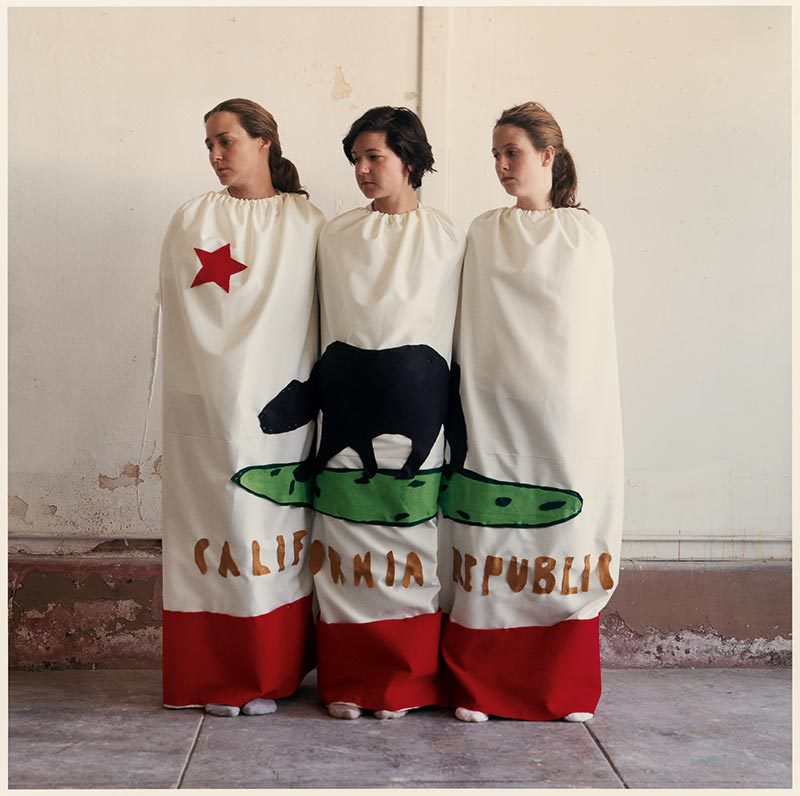
Sharon Lockhart, Untitled, 1997. Framed chromogenic print, 48 x 48 inches © Sharon Lockhart. Courtesy the artist; Gladstone Gallery, New York and Brussels; neugerriemschneider, Berlin
JB : You often mention the choreographer Yvonne Rainer as a point of reference, both as an artist and as a feminist figure. This ballet of bodies and this underlying political subtext exists since your Auditions, which also evoke the cultural construction behind teenage desire. How do you see the evolution of gestures in your work?
SL : When I look back at my earliest work, I realize that physical gesture was something I was always attuned to. I think, because of that, when I encountered Yvonne’s work for the first time it really resonated with me and gave me a framework for thinking about gesture and everyday pedestrian movement. I think in every photograph or film I’ve ever made there is some element of gesture that has leapt out at me.
JB : In your latest sets of photographs, you’re revisiting still life by embodying plants or wooden sticks in a tension between natural and artificial. Do you see this work as an extension of your research on the living and the inanimate, or possibly a questioning of the sterile opposition between nature and culture? Do you stage photography as an extension of your cinematic works, or the other way round?
SL : In general, I find the tension between categories and ways of looking to be productive. This was true in EWMN’s existence between science and aesthetics and in much of my work that somehow straddles document and construction. There is certainly a similar tension between still and motion pictures that George Baker wrote extensively about in his essay, Photography’s Expanded Field. I have always been interested in still life and Ikebana and how they, as you say, disrupt the sterile opposition between nature and culture. In the recent work with bronzes, I was particularly inspired by the possibilities opened up by creating multiples of the same object and the tension between truth and appearance that the bronze creates. The basic discourse of the copy that casting evokes is something I’ve been working with throughout my career in photography.
JB : How was the Baumettes project initiated? Is this initially a proposal from FID Festival ?
SL : At the closing ceremony of FID I met Annie who was the president of the Baumettes Prison jury. She was an inmate. I was so impressed that FID collaborates with the prison and that they were able to run the festival through the system. In talking with Annie, I found we had much to talk about given my experience with young women in a lockdown situation at Rudzienko. That night we shook hands that we would try to develop something together. When I was asked to propose a project for Manifesta I proposed the idea of “Baumettes”. The project was supposed to take place in the spring and summer of 2020 and we all know what happened…COVID. I couldn’t go to France and even my French collaborators couldn’t go to the prison. Everything was shut down. Since I had to rethink how I could carry out the project and how I could even create an interaction with inmates, I had to shift to a much more limited interaction. We used the medium of radio to get our message out to the prisoners and invite them to contact us. Annie had also been released so we were able to zoom a lot with her and other women recently out. These interactions became the text of the film. The idea of a film of just text was always at the heart of the project. In that first discussion with Annie at FID she told me that I could never get a camera in Baumettes and I said you don’t need a camera to make a film. The other condition of Baumettes was that it is a prison housing a wide-variety of languages, from French and the various European and North African languages to English and even Asian languages. Taking the ideas about text and translation that I developed in Rudzienko and working with that diversity of language seemed like the natural next step. I always thought the project would somehow revolve around the paradox of representing the diversity of voices and the absence of images. In a way I think COVID has had its plus moments. That sounds really strange to say but it challenged me to make films in a new way. Not in a million years would I have thought I would make a film using the low quality of a Zoom visual recording, or that I would be able to make a film with people that I was not with. We used the Zoom footage as an underlay to the text. What resulted is a very colorful structuralist film in eight different languages.
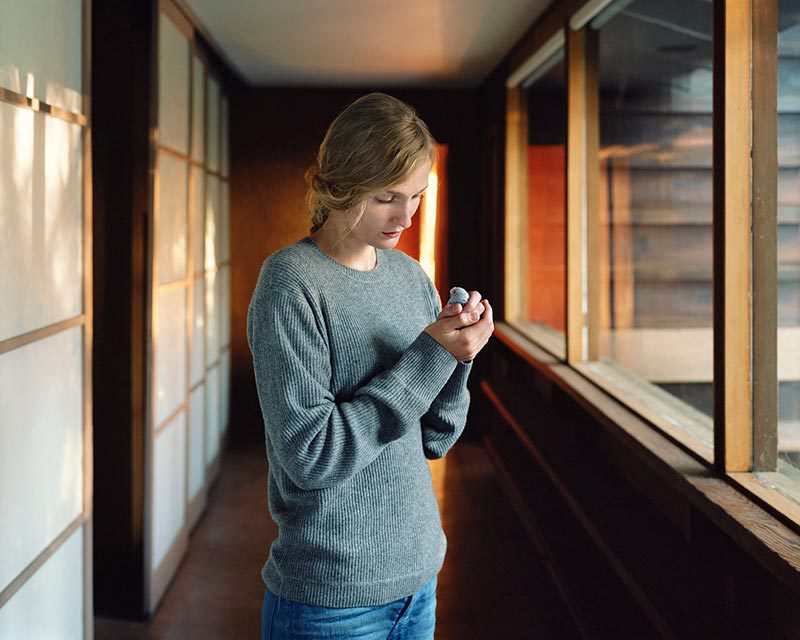
Sharon Lockhart, Untitled, 2011, Framed chromogenic print, 41 x 52 inches © Sharon Lockhart. Courtesy the artist; Gladstone Gallery, New York and Brussels; neugerriemschneider, Berlin
JB : Did you have any films in mind as a reference? From Frederick Wiseman’s Titticut Follies to Eugene Jarecki’s The House I live in, prison has often been treated in film, but women prisoners have been fairly under-represented.
SL : Yes, I’ve seen the films you’ve mentioned. There was a really interesting film by Raymond Depardon called 12 Days in 2017, just when I was wrapping up my Rudzienko work, that was very familiar to me. What that film did, and what I always imagined for “Baumettes”, was that it wouldn’t be so visually focused on the prison but more on the stories and voices of the inmates.
JB: James Benning and Mike Kelley were important figures in your professional and personal trajectory. They’re both fundamental artists with an awareness for human being in his environment, but with radically different approaches, tools, methods and procedures – naturalist and phenomenological for Benning, cultural and satirical for Kelley. To what extent did they inform/influence your own work?
SL : Mike, as one of my teachers, was hugely influential for me. His interest in undermining the ideological role of culture and embracing the taboo and rejected parts of society were inspirational. That Mike and James both came from working class roots was something that I found a connection to. James is someone I encountered after I had pretty much defined my practice but he has been incredibly helpful as a set of eyes and a friend. We both share every project with each other. James’ mathematical background and deep engagement with structure is something I find inspirational as well as helpful when I’m looking for ways to reappraise what I’m working on.
JB: How do you apprehend today’s culture of flow and immediacy, which seems to be the opposite of the phenomenological perception of time that you’re seeking in most of your films? While there’s an omnipresence of digital technologies within today’s society, you remove it in your work to look closely at tangible relationships between humans. Are you trying somehow to sustain this lost perception of time that relates directly to the flow of life itself?
SL: Asserting a slower tempo for viewing has always been part of my practice. Early on, I was quite committed to analog technologies and the structures that they provided. I liked the 10-minute takes that were part of 16mm film and the physical way the film ran through the projector. I also liked the space of the cinema, which was really a part of Goshogaoka (1997) and Teatro Amazonas (1999). However, I am not a purist in that respect. As digital technologies have approached the image quality of the analog ones I was using, I have adopted digital recording, editing, and projecting. They have allowed me to do things I would not have been able to do with analog. I agree with your idea that something about human relationships is at the center of my persistence in using long takes. I think there is something to allowing viewers to approach an image in their own time and give it as much or little consideration as they need. Attention spans have gotten shorter and shorter over the course of my lifetime. I find it refreshing when a filmmaker has the discipline to stay with a shot longer than the typical 2 or 3 seconds.
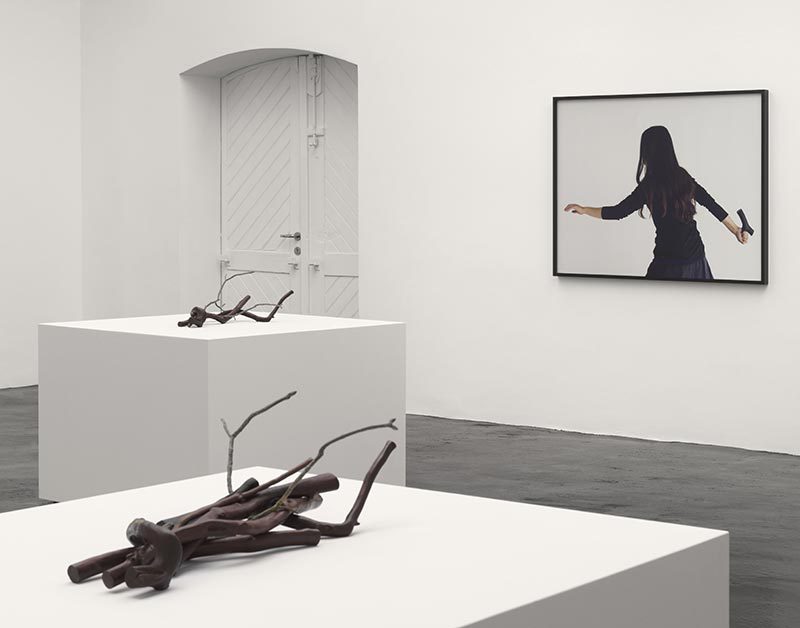
Installation view: Sharon Lockhart: Movements and Variations, neugerriemschneider, Berlin, DE, 2019. Courtesy the artist; Gladstone Gallery, New York and Brussels; neugerriemschneider, Berlin. Photo by Jens Ziehe
JB: Your art practice is crossing various mediums that are echoing each other. Photography is reflecting in cinema – especially in Lunch Break, through the decomposition of stills -, and reciprocally. This has a lot to do with a structural approach of cinema, I’m thinking especially of Michael Snow and Joyce Wieland, but also with the cinema of the origins, as invented by the Lumière brothers. Do you find yourself linked with this historical and anthropological side of photography and cinema, as Harry Smith or Henry Flynt related to the primitive side of music?
SL : As I said earlier, I like the ways in which tensions arise between science and aesthetics. In the earliest attempts at theorizing photography and cinema, there is a lot of rhetoric describing how these new media are science instead of aesthetics. Of course, we have come to recognize how this is problematic and ideological, but in those early examples there is a matter-of-factness and straight-forward approach that is refreshing in the way it privileges science.
JB: Your most recent films are part of installations and global projects of exhibitions. Would you be interested in directing a feature film within the cinema industry? I’m about to do an interview with film director Kelly Reichardt, and I wonder if you’re having any interest for such narrative forms of cinema.
SL : I love Kelly’s films and think that she is one of the very few directors challenging cinema. If a story that moved me were proposed and I could have my own vision – I would give it a try. But that world seems very different. I am just not built to pitch a project and raise funds.
Cover: Sharon Lockhart, Podwórka, 2009 (film still), 16mm film transferred to HD, color/sound, 31 min. 39 sec. © Sharon Lockhart. Courtesy the artist; Gladstone Gallery, New York and Brussels; neugerriemschneider, Berlin.
